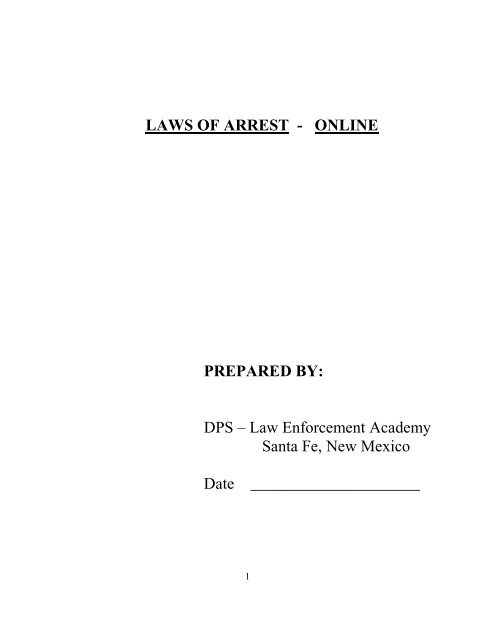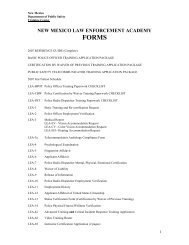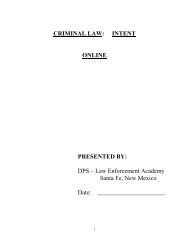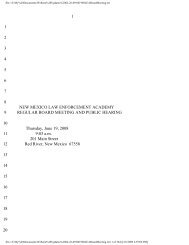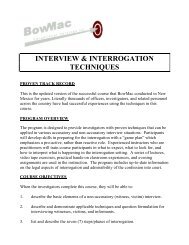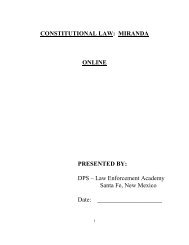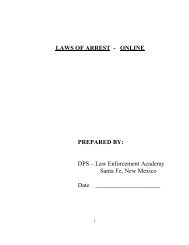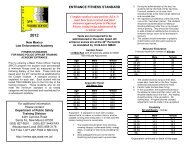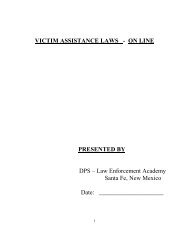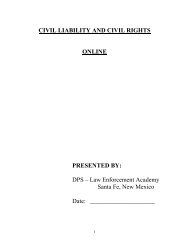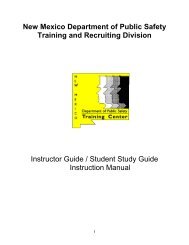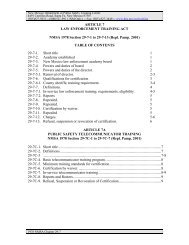LAW OF ARREST* - NMDPS Law Enforcement Academy
LAW OF ARREST* - NMDPS Law Enforcement Academy
LAW OF ARREST* - NMDPS Law Enforcement Academy
Create successful ePaper yourself
Turn your PDF publications into a flip-book with our unique Google optimized e-Paper software.
<strong>LAW</strong>S <strong>OF</strong> ARREST - ONLINE<br />
PREPARED BY:<br />
DPS – <strong>Law</strong> <strong>Enforcement</strong> <strong>Academy</strong><br />
Santa Fe, New Mexico<br />
Date<br />
_____________________<br />
1
GOALS<br />
• Students will appreciate the power – and responsibility – in their ability to make an arrest.<br />
• Students will recognize the potential for abuse under the laws of arrest.<br />
• Students will learn how to apply laws and procedures under New Mexico law.<br />
OBJECTIVES<br />
Upon completion of this course, students will be able to:<br />
• Define reasonable suspicion and probable cause.<br />
• Know what is needed to stop someone.<br />
• Know what is needed in order to “frisk” someone.<br />
• Describe what is involved in an investigatory detention.<br />
• Know the differences in making a misdemeanor and a felony arrest.<br />
• List the misdemeanor offenses when an officer can make an arrest although the offense<br />
did not occur in his or her presence.<br />
• Know when to get an arrest warrant.<br />
• Explain how location (defendant’s home or another) can affect serving an arrest warrant.<br />
• Know what consular notification is.<br />
• Know when the community caretaker exception applies in a vehicle stop situation.<br />
• Explain what is involved in a DWI checkpoint.<br />
• Learn the laws of vehicle stops.<br />
SOURCES<br />
• New Mexico Criminal and Traffic Manual.<br />
• New Mexico Statutes Annotated.<br />
• State and federal case law.<br />
ESTIMATED TIME<br />
Seven hours. (may go longer because topics often discussed in<br />
Search & Seizure are included).<br />
PREPARED BY<br />
Legal Instructor<br />
Department of Public Safety<br />
<strong>Law</strong> <strong>Enforcement</strong> <strong>Academy</strong><br />
Santa Fe, New Mexico<br />
DATE APROVED _____________ ACCREDITATION NUMBER ____________<br />
2
In Part I we’ll discuss the following:<br />
<strong>LAW</strong>S <strong>OF</strong> ARREST<br />
1) Introduction to <strong>Law</strong>s of Arrest.<br />
2) Reasonable suspicion and probable cause.<br />
3) What is needed to stop someone<br />
4) What is needed to “frisk” someone<br />
5) What is needed to arrest someone<br />
6) Issues involving an arrest.<br />
In Part II we’ll discuss the following:<br />
1) What is needed to do a vehicle stop<br />
2) Issues involving a vehicle stop.<br />
INTRODUCTION<br />
<strong>LAW</strong>S <strong>OF</strong> ARREST - PART I<br />
People familiar with the criminal justice system often comment on the tremendous power<br />
of Judges and ADA’s. ADA’s can indict people. Judges can sentence people to long periods in<br />
jail or prison. And yet ADA’s and Judges will tell you that it is the police officer who has an<br />
awesome responsibility. It is the police officer and only the police officer who has the discretion<br />
to stop or not stop someone, to detain or not detain someone, to arrest or not to arrest.<br />
We must remember that an arrest, no matter how small the offense, results in the loss of<br />
an individual’s personal freedom. We must never forget that it is the power given to us out of<br />
community trust and is not to be abused or seen as the sole solution in every situation.<br />
ARREST DEFINED<br />
The taking of a person into custody to answer for a crime. To arrest is to deprive a person<br />
of his or her liberty by legal authority.<br />
CONSTITUTIONAL FOUNDATIONS <strong>OF</strong> ARREST<br />
The primary amendment is the Fourth Amendment. It is the search and seizure<br />
amendment which also refers to “seizing” people. The right of the people to be secure in their<br />
persons . . . shall not be violated. The word “persons” refers to stops, detention, and arrests.<br />
The Fifth Amendment: No person shall be deprived of life, liberty, or<br />
property without due process of law. The term “liberty” refers<br />
to arrest.<br />
We are going to discuss and try to understand the following questions:<br />
• what is needed to stop someone<br />
3
• what is needed to “frisk” someone<br />
• what is involved in an investigatory detention<br />
• what is needed to arrest someone<br />
• what is needed to do a vehicle stop<br />
We will be looking for legal answers to these questions. To answer them,<br />
however, we need to understand and define legal terms such as reasonable suspicion and<br />
probable cause. <strong>Law</strong> enforcement, lawyers and the general public are all familiar with these<br />
terms. Unfortunately, it is difficult to come to a common agreement as to what these terms mean.<br />
REASONABLE SUSPICION AND PROBABLE CAUSE<br />
• What is reasonable suspicion<br />
• What is probable cause<br />
• What is the difference between the two<br />
It’s difficult to explain. That’s because reasonable suspicion and<br />
probable cause, like many legal terms, mean different things to<br />
different people.<br />
EXAMPLE<br />
An example may be the best way to clarify and understand reasonable suspicion and<br />
probable cause. Suppose it is 2:00 in the morning and we’re in a classroom. We’re in a high<br />
crime area. There is a business across the street. It can be any kind of business but this one sells<br />
televisions and DVD’s and so forth. The business is now closed.<br />
NO SUSPICION<br />
We look outside the window and see a young man walking through the parking lot in<br />
front of the store. The parking lot in front of the store is well-lit.<br />
Would you run out and stop the young man<br />
Would you demand ID<br />
Would you arrest him for concealing ID if he refused to give you ID<br />
ANSWER:<br />
An officer can question the young man and ask for ID. But the officer cannot stop (detain)<br />
the young man unless he or she has reasonable suspicion.<br />
The young man may refuse to provide ID. If we don’t have reasonable suspicion to detain<br />
him, we cannot arrest him for Concealing ID.<br />
REASONABLE SUSPICION<br />
It’s still 2:00 o’clock in the morning. You look outside and see a car in the well-lit<br />
4
parking lot.<br />
• A young man is standing besides the car.<br />
• The business alarm has just gone off.<br />
• You notice a broken window in front of the business.<br />
Do we have enough reasonable suspicion to detain this person (yes)<br />
To stop someone to investigate, to stop someone to the point they’re not free to leave, we<br />
need more than a hunch or a gut feeling. We need a reasonable suspicion that a crime has<br />
occurred, is occurring, or is about to occur.<br />
We’re suspicious, of course. But it’s not enough to say this looks suspicious. Is our<br />
suspicion reasonable We need to articulate our reasons for thinking so.<br />
• 2:00 o’clock in the morning.<br />
• Business closed.<br />
• Broken window.<br />
• Man walking away is the only person in the parking lot.<br />
• Alarm is going off.<br />
ANSWER:<br />
We have enough reasonable suspicion to stop this individual. At this point we do not<br />
have enough probable cause to arrest him.<br />
A simple, common-sense definition of Reasonable Suspicion:<br />
You’re suspicious and it’s reasonable that this person has done a<br />
crime or is involved in a crime.<br />
PROBABLE CAUSE<br />
We have sufficient reasonable suspicion to detain this person. To arrest someone, we<br />
need more: we need probable cause. We now will try to understand probable cause by<br />
continuing with this scenario. After a backup officer detains the subject, an officer might<br />
approach the crime scene investigation in the following way:<br />
Business<br />
• You notice fresh blood on the window sill.<br />
• You look inside the business and note that no one is inside.<br />
• You see a row of boxes of TV sets. In the middle of the row one TV box is missing.<br />
• There appears to be torn clothing by the broken glass.<br />
Vehicle<br />
• Inside the nearby vehicle you see a box similar to the row of boxes in the business.<br />
• You run the license plate and it comes back to John Smith.<br />
• John Smith lives on the other side of town.<br />
5
• You notice some fresh blood on the door handle.<br />
Person<br />
• The person appears to be nervous and sweating (it’s a cool night).<br />
• The person has fresh blood on his hands.<br />
• His clothing is torn and appears to match the torn clothing by the broken window.<br />
• The person gives you his ID. His name is John Smith.<br />
• He says he is looking for a friend’s house but doesn’t know where he lives.<br />
• The person has conflicting stories about the TV set in the back seat of his vehicle.<br />
Given the above factors, is there enough probable cause to arrest this person (yes)<br />
A simple common-sense definition of Probable Cause<br />
A crime has been or is being committed and this person<br />
“probably” did it. The important word is “probably”; this person more likely than<br />
not did this crime.<br />
There appears to be sufficient probable cause to arrest this individual.<br />
Another difference between reasonable suspicion and probable cause. Reasonable<br />
suspicion is when an officer arrives at a crime scene; probable cause is when an officer leaves the<br />
crime scene.<br />
Going to trial requires a higher standard: beyond a reasonable doubt. For example, we<br />
may need to get fingerprints from the subject, the broken window, and the TV set. We may want<br />
to compare blood of the subject, the door handle, and the TV set.<br />
The following chart gives legal requirements for officers:<br />
Police-citizen Encounter Stop Pat down Investigatory Arrest<br />
Detention<br />
No fourth amendment. Need Need Need<br />
Officer can always reasonable reasonable probable<br />
approach a citizen suspicion suspicion cause<br />
person is<br />
armed<br />
Police-citizen Encounter<br />
If a citizen is free to leave, the Fourth Amendment does not apply. A police officer can<br />
always approach and talk to a citizen.<br />
But when officers stop people, when they’re not free to leave, the Fourth Amendment<br />
kicks in and we have to follow court guidelines. We will discuss what happens in the following<br />
6
order:<br />
• stop.<br />
• pat down.<br />
• investigatory detention.<br />
• arrest.<br />
WHAT IS NEEDED TO STOP SOMEONE<br />
ISSUES INVOVED IN STOPPING SOMEONE<br />
Introduction:<br />
An officer needs reasonable suspicion to stop someone. The following case, involving an<br />
officer stopping a person to ask for ID, provides a good introduction to reasonable suspicion.<br />
Later on, when we get to vehicle stops, we will further discuss the issue of asking people for ID.<br />
Stop - ID Request<br />
Facts:<br />
An officer was in a neighborhood well known for drug trafficking. Two male subjects<br />
were standing in an alley, a few feet apart. When the subjects observed the police vehicle, the<br />
two male subjects walked in different directions. The officer stopped one of the male subjects<br />
because the situation “looked suspicious.” The officer “had never seen that subject in the area<br />
before.” The subject became angry and refused to give the officer any identification. He was<br />
arrested for concealing ID.<br />
• Was the officer correct in arresting the citizen for concealing ID (no)<br />
ANSWER:<br />
This case came from the United States Supreme Court. The officer had a right to talk to<br />
defendant and ask for identification. But when the defendant didn’t want to give the officer his<br />
identification, and wanted to leave, it became a stop. He was being detained.<br />
The problem is that the officer lacked reasonable suspicion to believe the defendant had<br />
been or was involved in criminal contact. The stop, once it became non-consensual, and given<br />
the absence of reasonable suspicion, was unlawful. Brown v. Texas (1979).<br />
Recommendation:<br />
If we stop someone to talk to them, and they’re free to leave, we need to make this clear<br />
to the court. STOP means not free to leave. More helpful words to assist the court might be:<br />
• Approach - free to leave<br />
• Made contact - free to leave<br />
• Consensual encounter - free to leave<br />
7
You’re an officer on the witness stand. How would you answer the following questions:<br />
• “Officer, could we agree that you stopped my client because you had a hunch he was<br />
involved in criminal activity” (no)<br />
• “Officer, would it be fair to say that you stopped my client because you had a gut feeling<br />
she had just committed a crime” (no)<br />
• “Officer, isn’t it true that you stopped my client because you felt things looked<br />
suspicious”<br />
(no)<br />
• Many officers use these words as if they had the same meaning. Unfortunately, if you<br />
answered yes to any of the above, it may mean dismissal of the case.<br />
Reminder:<br />
The legal standard to STOP someone is REASONABLE SUSPICION. Anything less (a<br />
hunch, a gut feeling, it looked “suspicious”) is not enough. The important thing is to articulate –<br />
go into detail – why you made a stop.<br />
Seizure – Free to Leave<br />
FACTS:<br />
At approximately 7:00 p.m., an officer in Clovis was called to a “possible domestic in<br />
progress.” The dispatcher said the caller wanted to have Joshua Garcia removed from the<br />
residence. As the officer got to the intersection nearest to the residence, he saw a man (Defendant<br />
Joshua Garcia) walking across the street.<br />
The officer didn’t know Defendant nor had a description been given of him. He shone his<br />
spotlight on Defendant, got out of his patrol car, and told Defendant to stop. Defendant continued<br />
walking. Pepper spray was used and Defendant dropped some crack cocaine to the ground. Will<br />
the cocaine be admissible as evidence (no) State v. Garcia (2009).<br />
Answer:<br />
Under these facts, there was no indication a crime had been committed. Walking in the<br />
vicinity of the location where the call came from is not reasonable suspicion. Nor is the time of<br />
day (7:00 p.m.) an unusual time to be walking. Supreme Court held there was no reasonable<br />
suspicion and ordered the drugs suppressed.<br />
Reminder:<br />
A person is ‘seized’ if he or she is not free to leave. An officer can seize (detain) a person<br />
if there is reasonable suspicion that the person detained is breaking or has broken the law. In this<br />
instance, when the Defendant was told to stop, he had been seized without reasonable suspicion.<br />
Recommendation:<br />
8
In a situation like this, officer can have a consensual encounter with the Defendant,<br />
permitting him or her the freedom to leave.<br />
Concealing ID - Obstructing<br />
Facts:<br />
Roswell police were advised that a vehicle not belonging to anyone in the neighborhood<br />
had been parked in front of a house for thirty minutes. It was late at night, 11:30 p.m., when an<br />
officer observed two males in the vehicle. Because of recent burglaries, he asked both people for<br />
ID. The driver was cooperative. The passenger gave his name and address but refused to give the<br />
officer his ID. He was charged with obstructing. State v. Hudson (2007).<br />
• Was the officer correct arresting the passenger for obstructing (no)<br />
ANSWER:<br />
The officer had a generalized suspicion about the situation. But he didn’t have an<br />
individualized reasonable suspicion that Defendant was committing or had committed a crime.<br />
The two subjects were sitting in a car, legally parked, and not involved in any criminal activity.<br />
In a situation like this, where the individual refuses to provide identification, and no<br />
individualized reasonable suspicion exists, that’s the end of the story. We cannot charge<br />
concealing ID or obstructing an officer. Conviction reversed.<br />
News item: Woman Arrested by APD Awarded $65k<br />
Albuquerque Police were dispatched to a lady’s home to investigate the complaint of a<br />
tow truck driver who said her son had driven a repossessed vehicle away and caused $4,000<br />
damage.<br />
The officer asked the lady for her son’s birthday and she said she didn’t know. The<br />
officer, believing her to be evasive, asked for her ID. When she didn’t produce it, she was<br />
arrested for concealing ID.<br />
The 10 th Circuit Court said there was no probable cause for the arrest. The federal jury<br />
awarded $65,000 in damages. The city will also pay legal fees. Albuquerque Journal,<br />
January 30, 2009.<br />
Reasonable Suspicion - Flight<br />
Facts:<br />
In Albuquerque, an individual sold drugs to an undercover officer. Defendant was among<br />
a group of eight to ten people standing nearby. When members of the “arrest team” arrived, the<br />
Defendant took off running. After numerous commands, he stopped. He threw crack cocaine<br />
underneath a car. Does his sudden running and being near a drug transaction support reasonable<br />
suspicion for a stop If not, the drugs will be inadmissible. State v. Harbison (2007).<br />
9
ANSWER:<br />
An individual walking away from a police officer, when there is no suspicion of a crime,<br />
can do so. He is “going about his business.” But running, an unprovoked flight, is not “going<br />
about one’s business.” In fact, it’s just the opposite.<br />
Supreme Court of New Mexico held that defendant’s presence near a drug transaction,<br />
combined with his unprovoked flight upon noticing police, supported reasonable suspicion for an<br />
investigatory stop. The stop being valid, the evidence seized was admissible.<br />
WHAT IS NEEDED TO FRISK SOMEONE<br />
ISSUES INVOVLED IN STOP AND FRISK<br />
Introduction<br />
In this section, we will look at a number of cases. If a pat down is good, the evidence will<br />
be admissible. If not, the evidence will be inadmissible. And one thing comes through in these<br />
cases, loud and clear: the extraordinary importance of articulating why we do what we do.<br />
Facts:<br />
Terry v. Ohio (1968). One of the most famous cases in American legal history. Stop &<br />
frisk, a pat down, a Terry stop . . . it’s all the same thing. It’s mid afternoon. A police officer is<br />
standing across the street from a jewelry store. He watches two men walk up to the jewelry store,<br />
look in, and continue walking. They come back and look in again. They do this about a dozen<br />
times. Soon they talk to a third man. The officer believes a robbery is about to take place. He<br />
confronts them and asks for ID. They are wearing heavy, out of season jackets. When one starts<br />
mumbling, he pats them down. On Terry he finds a handgun. Terry v. Ohio (1968).<br />
The Stop:<br />
A Terry stop is a “seizure” where someone is stopped and not free to leave. To do a Terry<br />
stop or pat down, fourth amendment guidelines must be followed. The legal standard for a Terry<br />
stop is reasonable suspicion. If an officer is able to articulate facts to support reasonable<br />
suspicion, this will be a good stop.<br />
The Frisk:<br />
A stop and a frisk is a two step process. The justification for the stop may not justify a<br />
frisk. A frisk is a search for weapons. If the officer is able to articulate facts to support<br />
reasonable suspicion the person is armed and dangerous, this will be a good frisk.<br />
• Are we able to articulate facts to support a stop (yes) A pat down (yes)<br />
ANSWER:<br />
The facts support reasonable suspicion for a stop. (1) Going back and forth and looking<br />
10
inside a jewelry store window. This suggests the three subjects are waiting for the cashier to be<br />
alone so that they can rob him or her. (2) The heavy out-of-season coats. These likely contain<br />
pockets to carry stolen jewelry.<br />
The facts also support reasonable suspicion for a pat down: (1) a possible robbery which<br />
is a violent crime, (2) the subjects wore heavy coats which can hide weapons, (3) there were three<br />
subjects confronting one officer, and (4) mumbling. Mumbling might indicate a person under the<br />
influence of alcohol or drugs or planning to “jump” the officer to make a getaway. United States<br />
Supreme Court upheld conviction of concealing a weapon, a felony offense in Ohio.<br />
An example of police department SOP for a stop and frisk:<br />
A “frisk” or feeling of the outer garments of an individual with the sole purpose of<br />
detecting a weapon.<br />
• If during the pat down for weapons we find drugs, and it is immediately apparent<br />
that we found drugs, the drugs will be admissible.<br />
Stop and Frisk<br />
(Gangs)<br />
Facts:<br />
Albuquerque Police Gang Unit officers in mid-afternoon were patrolling the “War Zone,”<br />
an area known for guns, gangs, drugs and violence. On a city sidewalk, less than a block away,<br />
they saw three males walking towards them. One male was a known gang member and drug<br />
dealer. The other two males appeared to be gang members.<br />
They did a stop and frisk of the three males. On one of them they found cocaine.<br />
A forcible stop or detention, more than a police-citizen encounter but less than an arrest,<br />
is a seizure under the Fourth Amendment.<br />
• A stop must be based upon reasonable suspicion<br />
• It must be a particularized suspicion that the person stopped has<br />
committed a particular crime.<br />
• The officers had generalized suspicions about gang members<br />
committing crimes.<br />
• Do the officers have anything connecting this individual defendant<br />
to a particular crime<br />
• Is gang membership, standing alone, sufficient to support<br />
reasonable suspicion.<br />
11
Good stop Good Frisk Will the evidence be admissible<br />
ANSWER:<br />
The state lost this case. Officers had nothing connecting this individual defendant to a<br />
particular crime. Being a member of a gang is insufficient to support reasonable suspicion. This<br />
doesn’t mean officers cannot be proactive. Officers can ask for consent to search. Defendant’s<br />
behavior may also be grounds for a pat down search. State v. Jones (1992).<br />
Stop – Reasonable Suspicion<br />
Facts:<br />
On the streets of Roswell, an officer beheld a strange sight. A car was parked, engine<br />
running, yet no one appeared to be inside. As he shined his spotlight he saw a person slouched<br />
down in the driver’s seat as if to hide. He said he was waiting for a friend. Meanwhile, his friend<br />
– Defendant – left a nearby house and attempted to enter the car. Officer told him to wait in front<br />
of the car. He began walking away. The officer stopped him, did a pat down, and found drugs.<br />
State v. Rivas (2006).<br />
• Good stop Good pat down Will the drugs be admissible (no)<br />
ANSWER:<br />
An officer can detain someone when there is reasonable suspicion that a particular<br />
individual, the one detained, is breaking, or has broken the law. In this instance, there is no<br />
indication that the defendant had committed or was about to commit a crime. Court of Appeals<br />
held the detention was improper. The cocaine seized was inadmissible.<br />
Stop and frisk (Violent Crimes)<br />
Facts:<br />
Radio dispatched a Hobbs police officer to a possible residential burglary in progress. The<br />
dispatcher advised two men were repeatedly going to the rear door of the residence and then<br />
returning to their vehicle. Officer arrived, saw two men leaving in a vehicle, and stopped them.<br />
Officer did a frisk (also known as a pat down) and found a syringe in one pocket and cocaine in<br />
the other. State v. Cobbs (1985).<br />
• Was the stop justified (yes)<br />
• Was the frisk (pat down) justified (yes)<br />
ANSWER:<br />
The stop was good. The dispatch plus the officer’s observations formed a reasonable<br />
suspicion that the two men might be engaged in criminal activity.<br />
The frisk was good. An officer has the right to frisk when a suspect is stopped for a type<br />
of crime for which the offender would likely be armed. Certain crimes are inherently dangerous:<br />
robbery, rape, assault with weapons, dealing in large narcotics actions, and burglary.<br />
12
Stop and Frisk (Non violent crimes)<br />
Facts:<br />
An officer in Lea County was dispatched to a robbery in progress at a convenience store.<br />
There was no robbery. The clerk was visibly upset. A very intoxicated male subject did not have<br />
enough money to pay for the items he wanted. He cursed and harassed the clerk and walked<br />
away. The officer stopped the subject. The officer knew that he had previously fought with police<br />
officers. He kept turning his body, as if hiding something or getting ready to confront the officer.<br />
The officer did a pat down and found a pistol. State v. Haddenham (1990).<br />
• Was the frisk justified (yes)<br />
ANSWER:<br />
Our focus will be on the frisk. We need to articulate (list) reasons to justify why a frisk<br />
was done. Some reasons would include:<br />
• The person was vey intoxicated.<br />
• The person had a record for previous disturbances with police officers.<br />
• The person was acting evasive, with body language suggesting a confrontation.<br />
Court of Appeals affirmed conviction of Felon in Possession of a Firearm.<br />
Stop and frisk (Officer Safety)<br />
Facts:<br />
In Lea County Officer A stopped defendant for speeding (41/25). As Officer A<br />
approached the vehicle, he smelled marijuana. Defendant stated he had a rifle in his car. Upon<br />
exiting the vehicle, Officer A asked Defendant if he had any weapons on him. Defendant said he<br />
had a pocketknife on him. Defendant acted “real nervous and fidgety.” After getting Defendant’s<br />
consent, Officer A performed a pat down but didn’t find anything. The initial pat down was<br />
proper. But then . . .<br />
Officer B arrived. With Defendant’s consent, Officer A searched the car but didn’t find<br />
anything. Officer A suspected Defendant had drugs on him and asked Officer B to do a pat down.<br />
Officer B saw a bulge in defendant’s sock and found meth. Officers testified at a motion hearing<br />
that the purpose of the second pat down was officer safety. State v. Pierce (2003).<br />
· Was the second frisk (pat down) good (no)<br />
· Is “officer safety” alone enough to justify a pat down (no)<br />
· What facts or reasons might be used to justify officer safety<br />
ANSWER:<br />
Court of Appeals held that the second pat down was illegal. Based upon the facts, the<br />
13
Court felt the motivation for the second search was not officer safety but to look for drugs.<br />
“Officer safety” is a valid concern but by itself the term doesn’t mean much. We need to<br />
articulate reasons or expand on the term to make it mean something. Example: “I patted him<br />
down for officer safety because he was intoxicated, moving his arms back and forth as if to fight<br />
or reach for a weapon, and was yelling at me.”<br />
Stop and Frisk (Pockets)<br />
Facts:<br />
Tucumcari police stopped a car because neither defendant nor his passenger was wearing<br />
a seat belt. Passenger was acting in a nervous manner. Passenger was patted down and arrested as<br />
a result of the pat down. Instead of patting Defendant down, officer asked him to step out and<br />
empty his pockets. Drugs (cocaine and marijuana) were found. State v. Ingram (1998).<br />
· A pat down search permits an officer to pat down the outer clothing to feel<br />
for weapons.<br />
· Did the officer exceed the bounds of the pat down search in directing<br />
Defendant to empty his pockets Is this a good pat down<br />
ANSWER:<br />
Court of Appeals held the search was improper. A pat down search (also known as a<br />
Terry search) for weapons may not be expanded into a search for evidence of a crime. In<br />
directing Defendant to empty his pockets, the officer exceeded the bounds of a Terry search.<br />
Evidence suppressed.<br />
WHAT IS INVOLVED IN AN INVESTIGATORY DETENTION<br />
An officer can forcibly stop (detain) someone when they have reasonable suspicion that<br />
the person has committed, is committing, or is about to commit a crime. We will now discuss<br />
what happens after a person is detained, the investigatory detention.<br />
Stop INVESTIGATORY DETENTION Arrest<br />
• Doing an investigation.<br />
• May clear subject or lead to an arrest.<br />
• Think of it as a “street stop” or “field stop”<br />
or “traffic stop.”<br />
• Person’s freedom of movement is restricted – not free to<br />
leave.<br />
• Detention is meant to be as brief as possible.<br />
14
• If an officer determines there is no probable cause the<br />
subject should be released from custody.<br />
Introduction to questions on investigatory detention<br />
Some questions we will discuss include:<br />
• How long are we allowed to detain someone<br />
• What guidance is there for handcuffing people who are detained<br />
• What issues exist regarding asking for ID<br />
• What issues regarding a show-up<br />
INVESTIGATORY DETENTION - HOW LONG<br />
Facts:<br />
Clovis police were contacted by an informant who gave his name but asked to remain<br />
anonymous. The informant advised that defendant would be delivering meth in a pickup truck<br />
that had a personalized license plate to a named address. Information was proved accurate when<br />
defendant was stopped just prior to reaching the address.<br />
Defendant refused to give permission to search her truck. A drug dog was called and she<br />
was told she was free to leave which she did. The dog, arriving 35 to 40 minutes later, alerted to<br />
the truck. A search warrant was obtained and meth was found in her purse and the truck.<br />
Defendant was charged with drug trafficking. State v. Robbs (2006)<br />
• Was this a good stop (yes)<br />
• Is detaining the vehicle for 35-40 minutes to wait for a drug dog too long<br />
• Will the evidence (drugs) seized be admissible) (yes)<br />
ANSWER:<br />
Court of Appeals held that the tip was sufficiently reliable because the informant was<br />
identified and the tip accurately predicted future movement of the defendant. This reliability gave<br />
the officers reasonable suspicion to stop the vehicle.<br />
The investigatory detention was reasonable in length. This was not a typical vehicle stop;<br />
it was a stop to investigate for drugs. The truck was detained to quickly confirm or dispel the<br />
officer’s suspicions. The drug dog was necessary to accomplish this and waiting 35-40 minutes<br />
for the dog was reasonable. Evidence was admissible.<br />
Lesson Learned:<br />
• Some officers ask if there is a set amount of time to do an investigation.<br />
There isn’t because a detention can vary depending upon the complexity of<br />
the case. The courts have stressed, however, that officers are not to go on<br />
“fishing expeditions”; in other words, a person should be released if there<br />
isn’t enough reasonable suspicion to detain them.<br />
15
FACTS:<br />
In Alamogordo, a police officer saw a vehicle in front of a house under investigation for<br />
drugs. Defendant was in the driver’s seat and another man was leaning in the window, talking to<br />
him. The officers suspected drug activity and followed the vehicle which was stopped for a<br />
cracked windshield.<br />
He recognized both the driver and passenger from previous drug activity. Defendant was<br />
nervous. When Defendant refused consent to search, he told him he could stay or go but he<br />
would call a drug dog. The dog arrived about ten minutes later, alerted, and defendant’s father<br />
who showed up gave consent. Offices found a handgun and meth. State v. Neal (2007).<br />
• Was there reasonable suspicion for the ten minute delay (no)<br />
• Will the evidence (handgun and meth) be admitted or suppressed<br />
ANSWER:<br />
The initial stop for the cracked windshield was valid. But what about the ten minute<br />
detention To detain someone there must be reasonable suspicion that the person is breaking or<br />
has broken the law. There must be reasonable suspicion, for example, that there are drugs in the<br />
vehicle.<br />
Talking to another person in front of a drug house is not reasonable suspicion. Being<br />
nervous is not reasonable suspicion. Having a criminal history is not reasonable suspicion.<br />
Supreme Court held that the officer did not have reasonable suspicion to detain the vehicle.<br />
Going from a cracked windshield to a vehicle search requires more. Evidence suppressed.<br />
Facts:<br />
On Interstate 40 New Mexico State Police stopped a vehicle going 84 in a 75. The driver<br />
gave the officer his California driver’s license and a vehicle rental contract. The contract revealed<br />
that Defendant was not listed as the renter or as an authorized driver.<br />
For about twenty-five minutes following the stop, the officer reviewed the contract, asked<br />
the driver and passenger about their travel plans, issued a speeding citation, and unsuccessfully<br />
sought to contact the rental company. At one point he asked if they had drugs and got consent to<br />
search. He looked into the trunk and found an estimated 20,000 small pills later identified as<br />
ecstasy. State v. Deng (2005).<br />
• Was the duration of the stop longer than necessary<br />
• Did the officer articulate – justify – reasons for asking about drugs<br />
• Will the evidence (drugs) seized be admissible<br />
ANSWER:<br />
The duration of the stop was reasonable. The scope of the detention, specifically whether<br />
the officer could inquire about drugs, presented a more difficult question.<br />
Fortunately, the officer was able to articulate – justify – why he was asking about drugs.<br />
16
He testified his reasonable suspicion was based on his experience and the following<br />
observations: (1) Defendant was not on the rental contract, (2) inconsistent stories from<br />
Defendant and the passenger regarding travel plans, and (3) Defendant’s nervousness. Supreme<br />
Court held that the scope of the detention was reasonable.<br />
INVESTIGATORY DETENTION - HANDCUFFING<br />
• Officers detain many people, make many traffic stops, without using handcuffs.<br />
• But sometimes, during a routine traffic stop or investigation, handcuffs are used.<br />
• In those cases it is helpful to articulate why a particular person was handcuffed.<br />
How would you judge the following civil lawsuit<br />
Facts:<br />
In Albuquerque, at Wal-Mart, a lady wrote a check for $208 for groceries and art<br />
supplies. The cashier looked at her driver’s license and noticed the hologram was missing. The<br />
cashier called police. An Albuquerque police officer cuffed her and she sat in the loss prevention<br />
room for 45 minutes while police investigated. She didn’t resist being handcuffed or attempt to<br />
flee. Finally, she was released and told the event would be written up as an “incident.”<br />
A federal jury ruled against the city and she settled for $100,000. Settlements were also<br />
made with MVD Express and Wal-Mart. The Judge noted, “A generalized suspicion that a<br />
person is attempting to use a fraudulent check or driver’s license . . . is not enough to justify the<br />
immediate intrusive use of handcuffs.” Albuquerque Journal, June 26, 2006<br />
• It is important to articulate – state reasons – why a person presents a threat to you.<br />
INVESTIGATORY DETENTION - SHOW-UP<br />
Facts:<br />
Eyewitnesses saw, from across the street, Defendant spraying cars with paint, and<br />
described (sort of) the men to the police. Ten days later police called the witnesses to a parking<br />
lot where they picked out the only brown car as the painter’s car. Police officers then brought a<br />
man outside and from 400 to 500 yards the witnesses identified him. Reliable identification<br />
State v. Johnson (2004).<br />
Answer:<br />
Court of Appeals held the identification was unreliable. The show-up was “highly<br />
suggestive” and tainted the in-court identification of the defendant.<br />
17
Lesson learned:<br />
Be careful when doing a show-up. Recommend noting the extent of what the witness saw<br />
of the suspect prior to the show-up.<br />
ISSUES INVOLVING AN ARREST<br />
Introduction<br />
In the following section we will address concerns regarding arrest.<br />
• Differences between a felony and misdemeanor arrest.<br />
• Arrest with a warrant.<br />
• How location (defendant’s home or another) can affect an arrest warrant.<br />
• Examples of exigent circumstances.<br />
• Arrest and domestic violence - is an arrest mandatory or discretionary<br />
• Special circumstances: Protective custody, mental disorders.<br />
• Drug overdose and arrests.<br />
• Consular Notification – what to do when a foreign national is arrested.<br />
• What to do with children when an adult is arrested.<br />
But before we begin these topics, let’s try to understand what a citizen’s arrest is.<br />
• A citizen’s arrest, which means to detain, allows a citizen to detain an offender<br />
until police arrive.<br />
Facts:<br />
Defendant in Lincoln County was watching television when he noticed headlights in the<br />
driveway. Curious, he went to his porch, looked out, and saw his truck backing down the<br />
driveway! He grabbed a pistol and drove after the truck.<br />
When he caught up with the truck, he confronted two repo men and pointed his gun at<br />
them. He fired a shot in the air and ordered the repo men to leave. They did. Neither he nor any<br />
member of his family attempted to call law enforcement. He argued that he was allowed to detain<br />
the two repo men because he had the right to make a citizen’s arrest. Is there a crime here Are<br />
his actions justified State v. Emmons (2007).<br />
ANSWER:<br />
A citizen’s arrest is meant to help law enforcement. Here, Defendant wasn’t seeking to<br />
assist law enforcement; this was about helping himself, being the vigilante. Defendant, a former<br />
certified police officer, pled no contest to two counts of aggravated battery with a deadly weapon.<br />
Lesson Learned<br />
“Citizen’s arrest” is not an accurate term. A citizen can detain a person but a citizen<br />
cannot arrest a person. We’ll continue to call it “citizen’s arrest” but it’s really “citizen’s<br />
detention.”<br />
18
Difference between felony and misdemeanor<br />
Felony<br />
• An officer doesn’t have to witness a felony to make an arrest. He or she can rely<br />
on hearsay – statements from others – as a basis for a felony arrest.<br />
Misdemeanor<br />
• Misdemeanors are a different matter. A peace officer, with certain exceptions, can<br />
only make a misdemeanor arrest if it occurs in his or her presence.<br />
• If the situation fits one of these exceptions the officer can arrest an offender even<br />
though the offense occurred outside his or her presence. We will now discuss the<br />
exceptions.<br />
Exception: Licensed Liquor Establishments<br />
NMSA 1978, Section 30-3-6. Reasonable detention, assault, battery, public affray or criminal<br />
damage to property.<br />
• This offense refers to offenses (assault or battery or public affray or criminal damage to<br />
property) that occur in a licensed liquor establishment.<br />
• “licensed premises” means all public and private rooms, facilities and areas in which<br />
alcoholic beverages are sold or served in the customary operating procedures of<br />
establishments licensed to sell or serve alcoholic beverages<br />
• Why do we have this exception In the old days there would be a barroom fight. Police<br />
would arrive but tell the manager they couldn’t do anything because it didn’t happen in<br />
their presence. Police would leave and the fight would start again. The “liquor lobby” was<br />
successful in getting the state legislature to pass this exception.<br />
Exception: Falsely Obtaining Services or Accommodations<br />
NMSA 1978, Section 30-16-16. Falsely obtaining services or accommodations.<br />
• Falsely obtaining services or accommodations consists of any person obtaining service,<br />
food, entertainment or accommodations without paying with the intent to cheat or defraud<br />
the owner or person supplying such service, food, entertainment or accommodations.<br />
• Any law enforcement officer may arrest without warrant any person he or she has<br />
probable cause . . . The officer doesn’t’ have to witness the offense; all that is needed is<br />
probable cause.<br />
• This includes dine and dash, gas skips, sneaking into movies, etc.<br />
• Why do we have this exception People who own restaurants, gas stations, and so forth<br />
19
were upset when officers wouldn’t arrest offenders. They went to the state legislature and<br />
were successful in getting this exception passed.<br />
Exception: Shoplifting<br />
NMSA 1978, Section 30-16-20. Crime of shoplifting created.<br />
• Any law enforcement officer may arrest without warrant any person he or she has<br />
probable cause for believing has committed the crime of shoplifting. The officer doesn’t<br />
have to witness the offense; all that is needed is probable cause.<br />
• A number of factors determine whether an officer will issue a citation or make an arrest.<br />
These include the attitude of the store owner, the amount of items taken, the type of items<br />
taken (baby food or alcohol), age, whether the person has ID or not, the person’s history,<br />
etc.<br />
Exception: Gambling<br />
NMSA 1978, Section 30-19-12. Duties of enforcement officers.<br />
• This article refers to illegal gambling where a Judge has issued a warrant. The peace<br />
officer shall arrest without a warrant the parties therein or making their escape and who<br />
would be subject to arrest with a warrant. The officer doesn’t have to witness the<br />
gambling; all that is needed is probable cause.<br />
• Gambling became legal in New Mexico in 1997. Since then, this exception is seldom<br />
used.<br />
Exception: Trespassers in Restricted Areas<br />
• NMSA 1978, Section 30-21-3. Detention or arrest of trespassers upon restricted areas.<br />
This article refers to trespass in restricted areas but is seldom used.<br />
Exception: Domestic Violence<br />
• Before the mid-1990’s, an officer would arrive at a misdemeanor domestic violence but<br />
couldn’t make an arrest. This exception permits an officer to arrest for domestic violence<br />
assault and battery even though it did not occur in his or her presence. We will be<br />
providing more information on domestic violence later on in this class.<br />
Exception: Traffic Offenses<br />
Misdemeanor traffic offenses must generally occur in the presence of a police officer to<br />
justify an arrest. There are a few exceptions:<br />
NMSA 1978, Section 66-8-125. Arrest without warrant.<br />
20
• Police may arrest without warrant any person:<br />
(1) present at the scene of a motor vehicle accident.<br />
• To arrest without a warrant, the arresting officer must have reasonable grounds, based on<br />
personal investigation which may include information from eyewitnesses, to believe the<br />
person arrested has committed a crime.<br />
Facts:<br />
Las Cruces police officers received a report a vehicle had crashed into a house. Both<br />
driver and passengers were gone. One passenger, found nearby, identified Defendant as the<br />
driver. Defendant was found at his home, also nearby, unconscious on the floor. He had visible<br />
injuries consistent with the deployment of an airbag.<br />
He was arrested for DWI and leaving the scene. Defendant argued the arrest violated the<br />
misdemeanor arrest rule because the offense did not occur in the presence of an officer.<br />
At issue was whether section 66-8-125 permits officers to arrest an individual without a<br />
warrant who has fled the scene of an accident before officers arrive, when the officers did not<br />
encounter the individual at the scene of the accident. State v. Sanchez (2009).<br />
Answer:<br />
Supreme Court held that an officer can arrest individuals who either are or were present at<br />
the scene of a motor vehicle accident, when the arresting officer has reasonable grounds, through<br />
personal investigation, to believe the individual has committed a crime. The arrest, however,<br />
must take place with reasonable promptness from the time of the accident.<br />
Arrest with a warrant<br />
When practicable, there are advantages to getting an arrest warrant:<br />
• Probable cause has been decided by a Judge.<br />
• Can be executed anywhere in the State.<br />
Do we need a warrant in the following situation<br />
Facts:<br />
Officers had been investigating subject for approximately one year and had probable<br />
cause to arrest him. Prior to arresting him the officers learned from a reliable confidential<br />
informant that the subject would be driving in Roswell, New Mexico the following day to do a<br />
drug transaction. The next day the officers saw the subject approach the intersection described by<br />
the confidential informant. The officers arrested the subject without a warrant. The officers<br />
searched the subject and his car. Seven packages of heroin were found. Campos v. State (1994).<br />
21
• Was this a reasonable arrest (no)<br />
• Is the evidence admissible (no)<br />
ANSWER:<br />
Officers had a year to get an arrest warrant. Supreme Court felt defendant’s arrest was<br />
unreasonable because there were no exigent circumstances.<br />
• An arrest without a warrant requires:<br />
Probable Cause + Exigent Circumstances<br />
• If an officer observes a felony, exigency is presumed.<br />
• Officers had sufficient time to get a warrant.<br />
• There were no emergency or exigent circumstances.<br />
• Therefore, evidence seized at time of arrest was inadmissible.<br />
Lesson learned: If we have time to get a warrant, we need to get a warrant.<br />
Place of Arrest - It makes a difference whether its suspect’s own house or that of another<br />
Entry into Defendant’s home to make an arrest<br />
Supreme Court held that officers, absent consent or exigent circumstances, need an arrest<br />
warrant to enter a suspect’s residence to arrest a suspect.<br />
• If you see or have good reason to believe a person is in her/his own<br />
house, you can enter the house to make an arrest if you have an<br />
arrest warrant. Payton v. New York (1980).<br />
Entry into Third Party’s home to make an arrest<br />
FACTS:<br />
DEA agents received a tip that a federal fugitive was in Steagald’s house, although the<br />
fugitive did not live with Steagald. The agents went to Steagald’s house and searched for the<br />
fugitive, whom they did not locate. However, they did observe cocaine and Steagald was<br />
charged.<br />
The United States Supreme Court held that:<br />
Unless officers have the consent of the resident or exigent circumstances are present, they<br />
must obtain a search warrant to enter a third party’s residence to search for a wanted person.<br />
The evidence (cocaine) was suppressed.<br />
• If you see a subject in another person’s house, you need an arrest<br />
warrant and a search warrant to enter the house. Steagald v. United<br />
22
States (1981).<br />
Entry into a shelter for battered women<br />
• A law enforcement officer needs to obtain a search warrant before<br />
attempting to serve an arrest warrant within a domestic violence<br />
safe house or shelter, absent exigent circumstances.<br />
• Employees of domestic violence safe houses or shelters do not<br />
commit either (1) the crime of resisting, evading or obstructing an<br />
officer, or (2) the cime of harboring a felon if they request a valid<br />
search warrant before allowing a law enforcement officer to enter<br />
the safe house or shelter.<br />
Arrest without a warrant: Need probable cause and exigent circumstances to enter house<br />
(Consent is also an exception to the warrant requirement)<br />
Examples of Exigent Circumstances<br />
• hot pursuit.<br />
• destruction of evidence.<br />
• danger to officer or others.<br />
• likelihood of escape.<br />
Information regarding arrest and domestic violence<br />
Domestic violence is discussed in a separate class. Some questions are frequently asked:<br />
when can an officer make an arrest, when is an officer required to arrest a person, and what<br />
happens if both parties in a domestic violence battery appear to be equally guilty<br />
When is it discretionary (up to the officer) to decide whether or not to make an arrest<br />
NMSA 1978, Section 31-1-7. Arrest without warrant; liability<br />
. . . a peace officer may arrest a person and take that person into custody without a<br />
warrant when the officer is at the scene of a domestic disturbance and has probable cause to<br />
believe that the person has committed an assault or a battery upon a household member.<br />
When is it mandatory (required) for an officer to make an arrest<br />
Chapter 40 of the New Mexico State Statutes is about domestic affairs. Article 13 relates<br />
to Family Violence Protection. In these cases, someone has already gone to see a Judge and has<br />
obtained an Order of Protection. One statute discusses a peace officer’s authority to arrest:<br />
23
NMSA 1978, Section 40-13-6<br />
A peace officer shall arrest without a warrant and take into custody a person whom the<br />
peace officer has probable cause to believe has violated an order pursuant to this section.<br />
What should an officer do if it looks like both offenders hit each other<br />
The State of New Mexico discourages dual arrests of persons involved in incidents of<br />
domestic abuse. An officer, making an arrest for domestic abuse, shall seek to identify and<br />
consider whether one of the parties acted in self-defense. NMSA 1978, Section 40-13.1.1.<br />
Alternatives to Protective Custody<br />
We have repeatedly stressed that we need probable cause to arrest someone. However,<br />
there are situations where we can take someone into custody without probable cause.<br />
Alternative to Probable Cause: Protective Custody<br />
NMSA 1978, Section 43-2-8<br />
An intoxicated or incapacitated person may be committed to a treatment facility . . . for<br />
protective custody if the authorized person has probable cause to believe that the person to be<br />
committed:<br />
• is disorderly in a public place;<br />
• is unable to care for the person’s own safety;<br />
• has threatened, attempted or inflicted physical harm on himself or herself or another;<br />
• has threatened, attempted or inflicted damage to the property of another;<br />
• is likely to inflict serious physical harm on himself or herself; or<br />
• is incapacitated by alcohol or drugs.<br />
Alternative to Probable Cause: Mental Disorders<br />
NMSA 1978, Section 43-1-10<br />
Facts:<br />
A police office was given a doctor’s note which authorized the officer to transport a<br />
patient to a mental health facility. The officer was concerned because of the absence of a legally<br />
valid order. What should the officer do<br />
ANSWER:<br />
An officer can, in specific situations, detain and transport a person for emergency mental<br />
evaluation and care in the absence of a court order. These exceptions are:<br />
• Person is otherwise subject to lawful arrest.<br />
• Reasonable grounds to believe the person has just<br />
attempted suicide.<br />
24
• If an officer has reasonable grounds to believe the person,<br />
as a result of a mental disorder, presents a likelihood of<br />
serious harm to himself or herself and that immediate<br />
detention is necessary to prevent such harm.<br />
Drug overdose and arrests<br />
• If a licensed physician or certified psychologist has certified<br />
a similar conclusion. Such certification shall constitute<br />
authority to transport the person.<br />
New Mexico has a high drug abuse rate. The legislature has tried to be innovative in<br />
coming up with new ways to reduce drug abuse.<br />
• A person who, in good faith, seeks medical assistance for someone<br />
experiencing a drug-related overdose shall not be charged or prosecuted<br />
for possession if the evidence was gained as a result of the seeking of<br />
medical attention.<br />
• A person who experiences a drug-related overdose and is in need to<br />
medical assistance shall not be charged or prosecuted for possession if the<br />
evidence was gained as a result of the overdose and the need for medical<br />
assistance. NMSA 1978, Section 30-31-27.1.<br />
Lesson learned:<br />
The idea behind this legislation is that a person who is going through an overdose or<br />
watching another go through an overdose will ask for help.<br />
Consular Notification: What to do when a foreign national is arrested<br />
• According to international treaty, if a person of one country is arrested in another country,<br />
the second country has an obligation to notify a consular of the first country. A consular,<br />
similar to an ambassador, looks out for the interests of their country’s citizens.<br />
• <strong>Law</strong> enforcement has an important role in this. Once an arresting officer determines a<br />
person is a foreign national, the officer needs to advise that person of their right to<br />
consular notification.<br />
• The officer should also inform the detention facility that the person is a foreign national<br />
and of their right to consular notification. Once done, the detention facility is responsible<br />
for consular notification.<br />
• The officer’s actions should be noted on the arrest/booking form and police report.<br />
What do do with children when an adult is arrested<br />
25
• Don’t forget the obvious! When arresting an adult, an officer should assist children<br />
(present or elsewhere) who may be at risk because of the arrest. This may include<br />
arranging temporary care for the children.<br />
CONCLUSION<br />
We have discussed many issues in Part I. In Part II of <strong>Law</strong>s of Arrest we’ll discuss:<br />
1) What is needed to do a vehicle stop<br />
2) Issues involved in a vehicle stop.<br />
26


